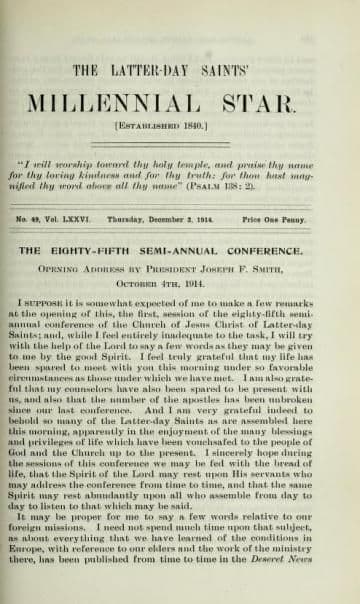Magazine
Book of Mormon Evidence

Title
Book of Mormon Evidence
Magazine
The Latter Day Saints' Millennial Star
Publication Type
Magazine Article
Year of Publication
1914
Authors
Sjodahl, J.M. (Primary)
Pagination
776–777
Date Published
3 December 1914
Volume
76
Issue Number
49
Abstract
This article argues that archaeological evidence that horses existed in ancient America supports the Book of Mormon. Furthermore, evidence of advanced textile art confirms the statement of “all manner of fine linen.”
BOOK OF MORMON EVIDENCE.
Some time ago the writer saw an article in an American magazine, by Charles Winslow Hall, on the Toltecs, which seemed to furnish striking evidence for the Book of Mormon.
The Toltecs inhabited Mexico before the Aztecs. Very little is known about them. They are supposed to have come to that country in the eighth century of our era, or about four hundred years after the Book of Mormon record was closed by Moroni. It is not known where they came from, except that they descended upon Mexico from the North. They were peaceful, industrious, and enterprising. They built cities and temples. They knew how to work in metals, make pottery, and polish stones, and they had a written language. In the eleventh century, it is said, famine and pestilence almost destroyed the nation, and the country was invaded and subjugated by the savage Aztecs, who still held sway when Cortez landed at Vera Cruz in 1519.
Mr. Hall says the women of the Toltecs were experts in spinning and weaving cotton in all degrees of fineness; some cloth was as light as muslin; some was coarser, while some of it resembled velvet. In some of the fabrics the fine hairs of animals and bright feathers were woven in so as to form beautiful patterns.
This is of considerable interest to the readers of the Book of Mormon, for in that sacred record we are told that the Nephite women were employed in spinning and making material for clothes. They made their fabrics of fine silk, twined, and twisted linen, etc., and the Lord often took occasion to rebuke them for the costliness of their apparel (Jacob 2:13, 14).
The Toltecs, also, according to the article referred to, had a correct understanding of the length of the year. They divided it into eighteen months of twenty days each, and added five days at the end of the year, thus making it three hundred and sixty-five days, and every fourth year they added another day, thus making a calendar essentially similar to the Julian, which was adopted at the suggestion of the Alexandrian astronomer, Sosigenes, in the year 45 B.C.
This, too, is of interest to the readers of the Book of Mormon. For this record tells ns that the Nephites were students of astronomy and had a correct understanding of the main motions of the heavenly bodies. They knew that the earth and the planets were moving in regular orbits (Alma 30:44; Helaman 12:14, 15).
In the article referred to we are further told that the Toltecs had various military orders and unions. One of these was known as the “Tecuhtlis.” It was subdivided into smaller branches or lodges, each with a name taken from the animal kingdom, such as the Tiger, the Lion, the Eagle, the Hawk. Each had its peculiar rites and ceremonies of initiation, as the knights in the middle ages.
From the Book of Mormon we know that Nehor, after he had left the church, murdered Gideon, and that later an order was formed called the Order of Nehor (Alma 14:16, 18; 15:15; 16:11; 21:4; 24:28). Gadianton was another apostate who formed bands or secret combinations, for the purpose of robbing their fellowmen (Helaman 3:23; IV. Nephi 1:42).
Concerning the Lamanites it is known that they became idolaters and that, toward the end of the time covered by the Book of Mormon record, they had sunk so low as to offer human sacrifices. They disposed in this way of the Nephite women and children whom they captured in war, and they even ate human flesh. Can anyone read this without being reminded of the condition of the Aztecs at the time of the conquest by the Spaniards? They worshiped a war god in whose honor they sacrificed men, women and children captured in war. They carried the victims in triumphant processions and to the strains of music to the temples, and there they bound them to the altar and, in sight of the assembled multitude, tore the hearts out of their breasts and then handed the bodies over to the captor to feast upon. It is said that there were as many as twenty thousand human sacrifices slain annually at that time.
The Book of Mormon tells us that a great war of extermination raged between the Nephites and Lamanites for about eighty years, and that, finally, a battle was fought at the hill Cumorah, as a result of which the Nephites, with the exception of a very few who had fled south, were exterminated. This was in the year 400 of our era. The Lamanites continued to make war upon one another. “In Central America, Mexico, Peru, and other places,” Mr. George Reynolds says, “the foundations of new kingdoms were laid, in which were gradually built up civilizations peculiarly their own, but in many ways bearing record to the idiosyncrasies of their ancient predecessors.” The Toltec and the Aztec empires evidently belong to this class. They bear witness to an unmistakable impress of Nephite and Lamanite civilizations respectively, and thus their history furnishes a strong evidence for the authenticity of the Book of Mormon.
J.M.S.
Subject Keywords
Bibliographic Citation
Terms of use
Items in the BMC Archive are made publicly available for non-commercial, private use. Inclusion within the BMC Archive does not imply endorsement. Items do not represent the official views of The Church of Jesus Christ of Latter-day Saints or of Book of Mormon Central.